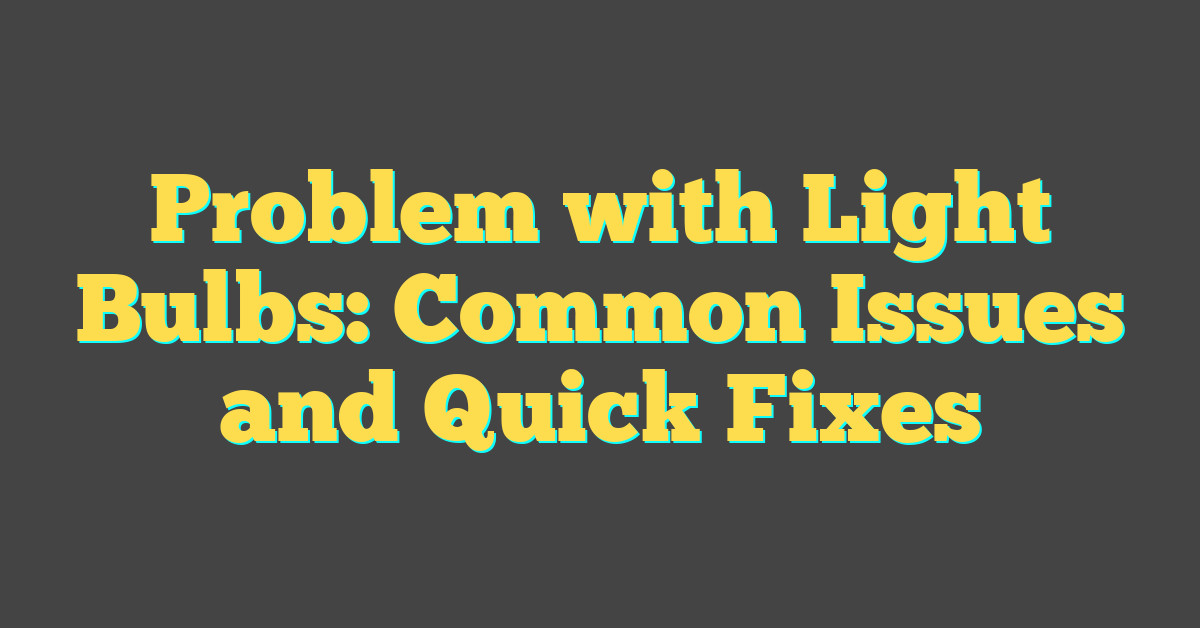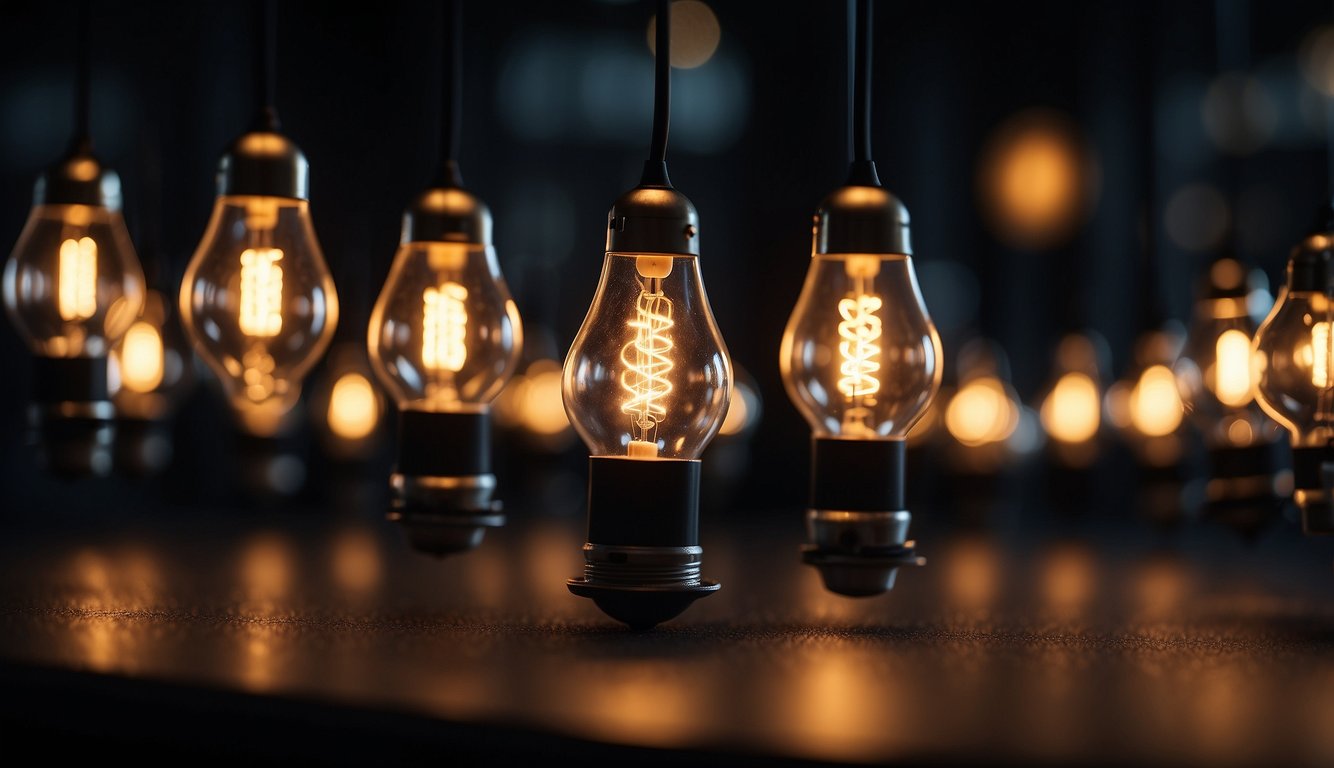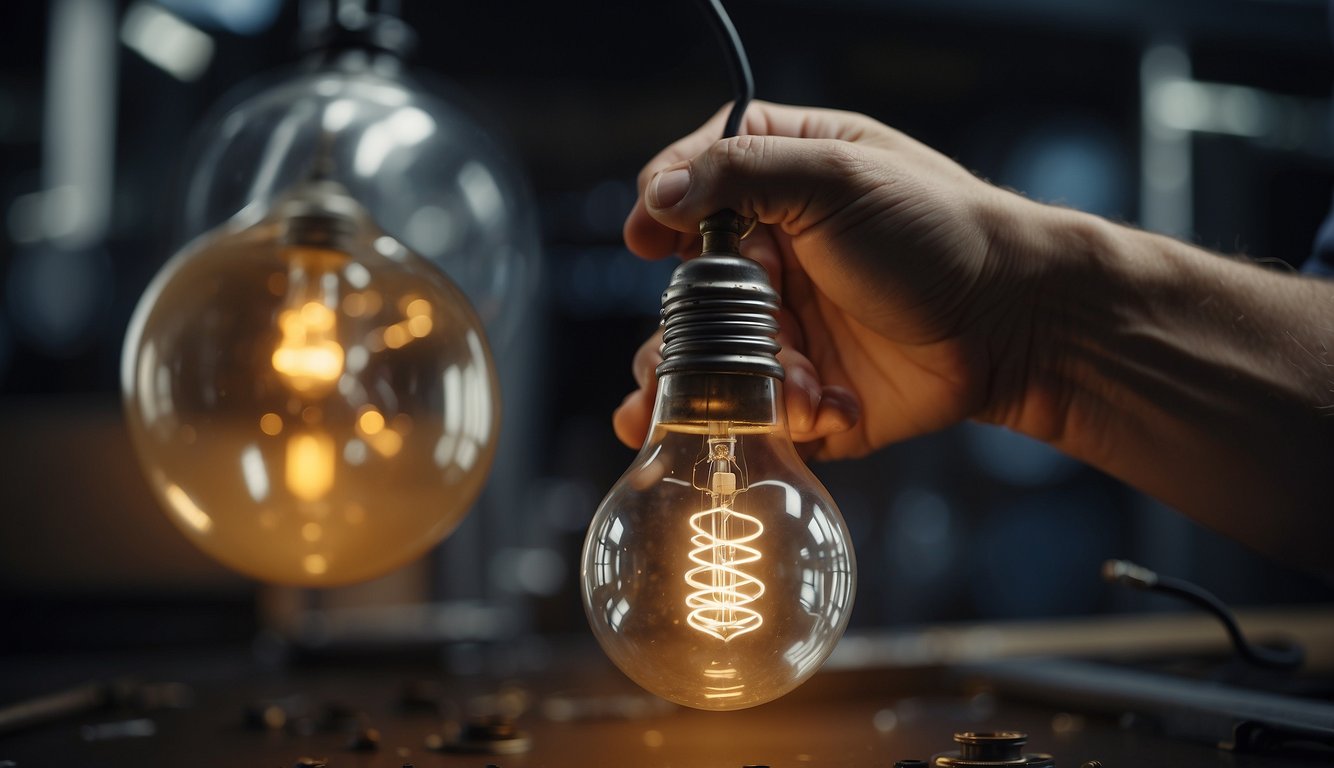Light bulbs are an integral part of your daily life, subtly providing comfort and convenience in your home and workspace. While they come in various shapes, sizes, and efficiencies, ranging from traditional incandescent bulbs to modern LEDs and CFLs, they can all experience problems despite their differences. Understanding the various issues that can arise with your light bulbs is essential to keeping your spaces well-lit and functional.


Maintaining your light bulbs and fixtures requires some basic knowledge of how they work and what they need to operate correctly. Regularly checking your fixtures and being aware of common issues can ensure that your lighting systems work efficiently. With advancements in lighting technology come new complexities in installation and maintenance, but with a bit of knowledge and the right approach, ensuring your bulbs last longer and perform better is quite manageable.
Key Takeaways
- Light bulbs, essential for illumination, can have diverse issues affecting their performance.
- Regular maintenance and understanding of lighting systems contribute to bulb longevity.
- Technological advancements in bulbs require updated knowledge for optimal use.
Types of Light Bulbs
https://www.youtube.com/watch?v=EalpCR4NV7U&embed=true
When choosing a light bulb for your home or office, you’ll encounter several types each with unique features and benefits. Let’s explore the most prevalent ones.
LED Bulbs
LED bulbs are known for their energy efficiency and long lifespan. They convert electricity to light using a diode and emit very little heat. LED lights can last up to 25,000 hours or more and use about 75% less energy than incandescent lighting. They’re an excellent choice if you’re looking for something that’s low maintenance and cost-effective over time.
Incandescent Bulbs
Incandescent bulbs are the traditional bulbs that many of us grew up with. They generate light by heating a filament until it glows. Although they are being phased out in favor of more energy-efficient options, you might still appreciate them for their warm, inviting light. However, they only last between 750 to 2,000 hours and are less energy-efficient, converting most of the electricity to heat rather than light.
CFLs
Compact Fluorescent Lamps (CFLs) are a type of fluorescent bulb. They consume about 70% less energy than incandescent bulbs and have a longer lifespan of around 8,000 hours. CFLs contain a small amount of mercury, so it’s important to handle them with care, especially when disposing of them.
Fluorescent
Fluorescent bulbs are commonly found in commercial spaces due to their long, tube-like shape which makes them suitable for illuminating large areas. They are more energy-efficient than incandescent bulbs and have a longer life — typically around 7,000 to 15,000 hours. However, the light they emit is often less cozy than that from incandescent bulbs and can flicker as they age.
Halogens
Halogens are a type of incandescent that produce a bright, white light and are more energy-efficient than traditional incandescent bulbs. They work similarly by heating a filament but have a halogen gas around the filament which increases brightness and improves efficiency. Halogen bulbs typically have a lifespan of about 1,000 to 3,000 hours and are fully dimmable, giving you control over the ambiance.
Each type of bulb offers unique advantages, whether it’s the efficiency and long life of an LED, the classic warmth of an incandescent, the economy of CFLs, the broad coverage of fluorescent tubes, or the bright intensity of halogens. Your choice will depend on your specific lighting needs and preferences.
Understanding Light Bulb Fixtures
https://www.youtube.com/watch?v=2X8NTS7WXZg&embed=true
When you’re choosing light bulbs, knowing the specifics of your light fixtures is crucial. The right bulb ensures both optimal functionality and safety.
Fixture Compatibility
Your light fixture’s design and capacity determine which bulbs will function properly without causing damage. Ensure that the wattage of the bulb matches what your fixture allows; mismatched wattage can lead to overheating or insufficient illumination. For example, if your ceiling light fixture supports up to 60 watts, using a 75-watt bulb could pose a fire risk.
Adapters may offer a solution when your preferred bulb type doesn’t fit your fixture. These inexpensive options can bridge the gap between the bulb base and socket type. It’s essential to use adapters that match your fixture’s requirements.
Socket Types
« Light Bulbs Instead of Candles: Embracing Modern Illumination
Replace Light Bulbs Landlord: Quick Guide for Tenants and Owners »
Light bulb sockets come in various sizes and designs. The most common type you’ll encounter in residential settings is the E26 socket, which pairs with the standard bulb base size in North America. Other regions often use the E27 socket, with the number representing the diameter in millimeters.
Another common type found particularly in UK households and commercial settings is the B22 bayonet socket, noted for its push-and-twist action. Choose a bulb with a base that corresponds to your light fixture’s socket to ensure it fits securely without the need for a forced adjustment.
Electrical Basics for Light Bulbs
https://www.youtube.com/watch?v=oYAZgAdf0As&embed=true
Understanding the basics of how light bulbs function within an electrical system helps ensure that you select the right bulb for your needs and maintain safety. Here, you’ll gain insights into circuit functionality and the importance of matching voltage and wattage.
Circuit Functionality
Your home’s electrical system is like a lifeline that powers appliances and lighting. Circuits—paths through which electricity flows—are crucial for powering light bulbs. For a bulb to light up, it must be part of a complete circuit where electricity flows from the power panel, through the fuse, to the light bulb, and back to the panel. If there’s a break anywhere in this path, the circuit is open, and the bulb won’t work. Remember, your light bulbs are only one part of the whole electrical system—everything needs to be correctly connected and functioning to work.
Voltage and Wattage
Ensuring that your light bulbs have the correct voltage is key. Voltage is essentially the pressure from your electrical system’s power source that pushes electricity through the circuit. Most North American homes have a standard voltage of about 120V. Using a bulb with a voltage rating that matches the system’s output is necessary to prevent any electrical issues.
Regarding wattage, it tells you how much power a bulb consumes. A higher wattage means more electricity is used to make the light brighter. It’s vital to use bulbs that meet or are lower than the wattage specified for the fixture to avoid overheating, which could damage the fixture or even cause a fire.
Remember, always check both voltage and wattage before installing a light bulb to ensure compatibility and safety in your home’s electrical system.
Common Light Bulb Issues
Lighting issues in your home can be more than just an annoyance; they can signal underlying problems in your electrical system. From bulbs that flicker and dim to complete burnouts, let’s address the most common light bulb issues you might encounter.
https://www.youtube.com/watch?v=VdiB_ArK_MU&embed=true
Flickering and Dimming
Flickering or dimming in light bulbs can often be attributed to voltage fluctuations or incompatible dimmer switches. If you notice flickering light bulbs, it might indicate changes in your home’s voltage. This can occasionally be caused by circuit overload or other appliances drawing a large amount of power suddenly. To fix a flickering light bulb, first ensure it’s screwed in securely. If the issue persists, you may need to check for loose wiring or consider whether the dimmer switch is suitable for the bulb, especially if it’s an LED.
Bulb Burn Out
Bulb burn out happens; it’s a natural part of a bulb’s lifecycle, but sometimes it can occur prematurely. The filament inside the bulb can weaken over time, especially if exposed to frequent voltage changes or overheating. An overheated bulb can shorten its lifespan and burn out faster. Keep your bulbs free from dust and ensure they’re the correct wattage for their fixtures to prevent overheating and extend their life.
Loose Connections
A loose connection may cause your bulb to flicker, come on intermittently, or not turn on at all. A loose bulb in the socket is a common culprit and is easily fixed by gently tightening the bulb. However, if the connection issues stem from loose wiring in the fixture or switch, it’s wise to consult with an electrician to prevent potential electrical problems. Remember, working with electricity can be dangerous, so always put safety first.
Troubleshooting and Repair
https://www.youtube.com/watch?v=n9EJHbAQujE&embed=true
In this section, you’ll learn how to identify the cause of common light fixture issues and the steps to repair them. Should the problem be complex or risky, you’ll know when it’s crucial to contact a licensed electrician.
Diagnosing the Issue
First, check if the light bulb is functional by replacing it with one you know works. Inspect the socket; if it appears damaged or burnt, it’s possibly due to using an incorrect bulb type. Often, a simple adjustment like tightening the bulb or bending the metal socket tab can restore functionality. For fluorescent light fixtures, replacing a flickering or dim tube may resolve the issue, as long as the starter and ballast are in working order.
- Light Bulb: Ensure it’s not burnt out and fits snugly.
- Socket: Look for damage or signs of wear.
- Connections: Tighten any loose wires or contacts.
When to Call an Electrician
If you’re not experienced with electrical repair or if the problem persists after performing basic troubleshooting, it’s safest to call a licensed electrician. This includes scenarios like:
- Persistent flickering even after bulb replacement
- Signs of electrical burning or fire hazards
- Buzzing sounds from the fixture
- Complicated issues like wiring problems or malfunctioning switches
Remember, safety comes first. If you’re unsure at any point, don’t hesitate to seek professional help. Repairing electrical fixtures can be dangerous and is often best left to those with proper training and equipment.
Lighting Controls and Dimmers
https://www.youtube.com/watch?v=hiEmFtLhbJg&embed=true
When you’re looking to enhance your home lighting, dimmer switches can give you the flexibility to set the mood and save energy. However, pairing your light fixtures with the right type of dimmer is crucial for both function and longevity.
Using Dimmer Switches
To use dimmer switches effectively, it’s important to ensure that your light bulbs are dimmable and that the dimmer switch is compatible with them. Dimmer switches allow you to adjust the brightness of your lights, but not all light bulbs or fixtures are designed to work with these switches. When you use a dimmer, you’re controlling the voltage that reaches the light bulb. This can help lengthen the life of your light bulbs and can lead to energy savings because when you dim a bulb, you’re using less electricity.
- Traditional Incandescent Bulbs: Usually compatible with most dimmers.
- LEDs: Require compatible dimmer switches known as LED dimmers.
Before purchasing a dimmer, check the label on your light bulbs to ensure they’re labeled “dimmable.” Non-dimmable LEDs in a dimmable circuit often result in flickering or premature bulb failure.
Compatibility Issues
Encountering issues with incompatible dimmer switches is common if you’ve upgraded to LED lighting without changing your old dimmers. Dimmer compatibility is not just about the bulb; it also hinges on the dimmer’s design to handle specific loads. An incompatible or faulty dimmer can cause a variety of problems like flickering, buzzing, or failure to adjust the light properly.
- Check the Wattage: Ensure that the minimum and maximum wattage of the dimmer matches your lighting load.
- Quality: Opt for higher quality dimmer switches that are designed to handle various types of light bulbs.
To avoid compatibility issues, ensure you’re using dimmer switches that are specifically designed for the type of bulbs you have. If your lights are flickering or not dimming smoothly, consider upgrading your dimmer switch (Here’s a guide to troubleshooting dimmer switches). Remember, a little bit of research before choosing a dimmer can save time and hassle in the long run.
Advancements in Lighting Technology
https://www.youtube.com/watch?v=ShmiGH4RTx0&embed=true
In recent years, you’ve seen a significant shift in lighting technology, moving away from traditional bulbs towards more sophisticated and energy-efficient solutions.
Energy-Efficient Lighting
LEDs and LED bulbs have set the benchmark for energy efficiency in lighting. Compared to traditional incandescent bulbs, LED technology uses up to 75% less energy. This not only helps you save on your electricity bills, but it also contributes to a reduction in carbon emissions—one of the key advantages of LED lighting as highlighted by energy5.com. LEDVANCE, as a leading manufacturer, continues to invest in the development of newer, more efficient LED solutions.
| Bulb Type | Energy Efficiency | Lifespan |
|---|---|---|
| Incandescent Bulbs | Low | 1,000 hours |
| LED Bulbs | High | Up to 25,000 hours |
Not only do LEDs outshine their predecessors in terms of lifespan, but advancements have also seen these bulbs improve in luminosity and color rendering, making them more versatile for both home and commercial use.
Smart Bulbs and Features
Smart bulbs represent the intersection of lighting and technology, offering you features that were once considered futuristic. With smart bulbs, you can control the lighting in your home from your smartphone or via voice commands, thanks to compatibility with digital assistants. These bulbs can be scheduled to turn on or off, change colors, and even adapt their brightness according to the time of day, which adds to their energy-saving capability.
Here’s a simple breakdown of what smart bulbs offer:
- Remote access and control
- Adjustable color temperature
- Scheduling and automation
- Voice command compatibility
The emergence of smart, energy-efficient lighting has undeniably transformed the way you illuminate your spaces, giving you convenience while being kinder to the planet.
Safeguarding Your Lighting System

To protect your home and extend the life of your lighting, it’s important to prevent heat-related damage to your light bulbs. Proper air circulation and avoiding overload are critical steps.
Preventing Overload and Overheat
- Check the Bulb’s Wattage: Ensure that you use light bulbs with the appropriate wattage for your fixtures. Overloading with higher wattage bulbs can cause overheating.
- Use Heat Sinks: Install bulbs with built-in heat sinks to dissipate excess heat. These components effectively manage the temperature and can significantly extend the life of your bulbs.
Ensuring Proper Air Circulation
- Avoid Insulation Blockage: When installing light fixtures, ensure that insulation doesn’t block air circulation around the bulbs, as this can trap heat.
- Allow Space: Give your light bulbs sufficient room to “breathe”. Don’t pack too many bulbs into a confined space or use dense lampshades that limit air flow.
Installation and Maintenance

Proper installation and regular maintenance of your lighting fixtures and bulbs can prevent many common lighting problems. Ensuring correct wire connections and choosing quality bulbs are key for the longevity and functionality of your lights.
Installing Recessed Lights
When you’re installing recessed lights, the accuracy of your measurements is crucial for a seamless fit. First, ensure you disconnect the power to avoid electrical hazards. After cutting the holes for the housing, connect the wires to the fixture’s junction box. It’s important that the wire connection is secure and follows your local electrical code. If you’re unsure about the process, hiring an electrician can be a wise decision to ensure safety and proper installation.
Replacing Ballasts and Starters
If you have fluorescent lights, you might have to replace ballasts or starters over time. Always turn off the electricity before you start. For ballasts, disconnect the old one and connect the new one, matching wire colors—usually, black and white wires for power and blue and red for bulbs. Starters are easier to replace: simply twist them counterclockwise and replace with a new one. Remember, mismatched ballasts and bulbs can lead to problems, so check the specifications.
Regular Inspection and Testing
Conducting regular inspections and testing can significantly extend the life of your light fixtures and bulbs. Look for signs of wear, such as frayed wires or corrosion. Test the functionality of the light switch and dimmer to ensure they operate correctly with your lighting. If you experience flickering or buzzing, it might be time to replace your light bulbs with quality bulbs compatible with your fixtures. Loose wire connections can also cause issues, so tighten any that seem loose or call an electrician if you’re not confident in doing it yourself.
Choosing the Right Bulb for Your Space
https://www.youtube.com/watch?v=IbWAVyAl2so&embed=true
Choosing the right light bulb for your space involves understanding wattage and color temperature to ensure that you have efficient, long-lasting, and comfortable lighting.
Determining Appropriate Wattage
The wattage of a light bulb indicates how much energy it uses. With LEDs being more energy-efficient, you can achieve the same brightness with less wattage. For example, where you once needed a 60-watt incandescent bulb, an 8-watt LED provides the same light output. This not only conserves energy but also reduces heat emission, making LEDs a cooler option for fixtures like a ceiling fan.
Selecting the Adequate Color Temperature
Color temperature is measured in Kelvins (K) and influences the feel of a space. Bulbs around 2,700 to 3,000 K emit a warm light, creating a cozy atmosphere, ideal for living rooms with standard light fixtures or lamps. For task-oriented spaces like workshops or laundry rooms, choose bulbs with around 5,000 K for a cooler, daylight-like quality, enhancing your visibility and concentration. Remember that the right color temperature contributes to the lifespan of your bulb and the overall ambiance of the room.




